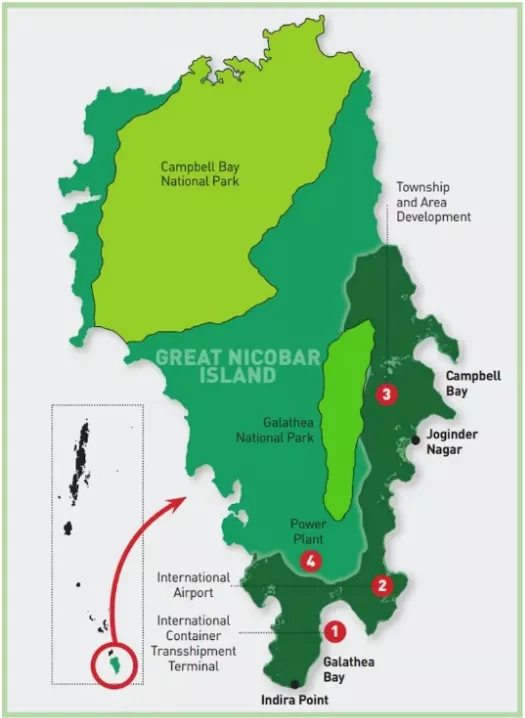The Great Nicobar project is raising concerns over ecological governance, tribal rights, and compliance with environmental laws, including the Forest Rights Act, 2006
About Great Nicobar Island Project
- Vision: A multi-component mega development project to transform Great Nicobar into a logistics, trade, and defence hub, improving India’s presence in the Indian Ocean.
About Andaman and Nicobar Islands Integrated Development Corporation Ltd (ANIIDCO)
- About: Quasi-government agency, incorporated in 1988 under the Companies Act.
- Objective: To develop and commercially exploit natural resources for the balanced and environment friendly development of the territory.
- Appointment as Project Proponent: Appointed by A&N administration in July 2020 for the Great Nicobar Project.
|
- Planned with environmental safeguards and tribal welfare compliance under EIA Notification 2006 and Shompen Policy 2015 to ensure sustainability
- Shompen Policy 2015: It is a regulatory framework established by the Andaman and Nicobar Administration to prioritize the welfare and rights of the indigenous Shompen tribe during large-scale development projects on Great Nicobar Island.
- Implementing authority: Andaman and Nicobar Islands Integrated Development Corporation Ltd (ANIIDCO).
What are Bio-cultural Rights?
- Bio-cultural rights refer to the collective rights of indigenous and local communities to protect and manage their natural habitats and cultural traditions that are closely linked to those ecosystems.
- These rights recognize that biodiversity and culture are interdependent, ensuring communities can sustainably govern their environment while preserving their identity and heritage.
- For Example: In 2016, Colombia’s Constitutional Court introduced the concept of bio-cultural rights—acknowledging the inseparable link between these communities and their natural environment.
|
- Phased Timeline: Construction from 2024 onwards; partial operationalization by 2028, with full-scale development spread till 2050.
Key Components
- International Container Transhipment Terminal (ICTT): With a capacity of 14.2 million TEU, it will reduce India’s reliance on Colombo/Singapore and position the island as a global shipping hub.
- It is part of Maritime India Vision 2030 and Amrit Kaal Vision 2047, supporting India’s long-term economic strategy.
- Greenfield International Airport: Will improve air connectivity, promote tourism, and enable rapid deployment of troops and supplies in emergencies.
- 450 MVA Gas + Solar Power Plant: Ensures uninterrupted energy supply with a mix of conventional and renewable sources for sustainable growth.
- Integrated Township: A planned township over 16,610 hectares to provide housing, infrastructure, and modern amenities to residents and workers.
- Phased Development: Divided into three phases (2025–47) to spread investment, minimise ecological stress, and allow adaptive planning over two decades.

Location – Great Nicobar Island (GNI)
- Southernmost island of the Nicobar group of islands in the Bay of Bengal.
- Protected Sites:
- Great Nicobar Biosphere Reserve
- Campbell Bay National Park
- Galathea National Park
- Ecological Significance:
- High biodiversity with unique flora and fauna, including endangered species.
- Important for marine life and coral reefs.
- Designated a World Network of Biosphere Reserve by UNESCO in 2013.
|
Significance of the Project
- Strategic Location: Great Nicobar lies near the Malacca Strait, through which nearly 30%-40% of global trade, including a large share of China’s oil and gas imports, passes through this chokepoint.
- Economic Potential: It supports Sagarmala initiative and aims to make India a regional transshipment hub like Singapore/Hong Kong.
- Infrastructure Development: Four major components:
-
- Transshipment port (14.5M TEUs annually).
- Greenfield international airport.
- 450 MW power plant (Gas + Solar).
- Township for ~65,000 people.
- Improves connectivity and infrastructure in a remote region.
- Defence Importance: Enhances naval and air operational capacity in the eastern Indo-Pacific.
- Regional Diplomacy: Positions India as a trade and logistics leader in Bay of Bengal and BIMSTEC region. It helps in reducing dependency on foreign ports for transshipment.
Concerns Associated with the Project
- Ecological Concerns: Great Nicobar is a biodiversity hotspot (200 bird species, endemic flora, coral reefs).
- Galathea Bay: Critical nesting site for giant leatherback sea turtle and Ramsar wetland with protective mangroves.
- UNESCO World Heritage Site candidature could be jeopardized.
- Tribal Rights and FRA Issues
- Shompen Tribe (PVTG) (~300–400 people): Risk of displacement from 130 sq km of ancestral & sacred lands.
- Vulnerability to disease due to isolation (No immunity to outside pathogens).
- Forest Rights Act (2006):
- Requires recognition and settlement of rights before diversion of forest land.
- Complaint filed that administration falsely certified FRA compliance in 2022.
- Gram Sabha consent allegedly not properly obtained which is in violation of FRA spirit.
- Governance and Institutional Concerns: ANIIDCO appointed as project proponent despite limited experience (previously handled liquor, milk, tourism resorts).
- Lack of environmental policy & expertise until 2022 → questions of credibility.
- Conflict of Interest: Same officials heading ANIIDCO also in charge of environmental oversight and clearances.
- Raises doubts about independent monitoring and transparency.
- Legal and Regulatory Concerns: Project area includes Coastal Regulation Zone (CRZ-1A) → normally prohibits large-scale construction.
- Environmental clearance by MoEFCC despite lack of preparedness flagged as irregular.
- Ongoing petitions before NGT & Calcutta High Court challenge forest clearances.
- Political & Social Concerns: Opposition parties (Congress, etc.) criticize the project as “planned misadventure.”
- Risk of becoming a politically divisive issue instead of a consensus-driven development plan.
What is Earth Jurisprudence?
- Earth Jurisprudence is a legal philosophy that recognizes nature as a living entity with inherent rights. It shifts focus from human-centered (anthropocentric) laws to eco-centric governance, granting legal personhood to natural entities like rivers, forests, and mountains, allowing them to be represented and protected in court.
For Example
- In 2017, the Uttarakhand High Court granted legal personhood to the Ganges and Yamuna rivers, as well as the Gangotri and Yamunotri glaciers.
- The judgment, in Mohd. Salim vs State of Uttarakhand and Others, conferred these entities with rights and obligations but only through a designated person.
|
Way Forward
- Earth Jurisprudence: Countries like Bolivia, Colombia, Ecuador, and New Zealand follow ‘earth jurisprudence’ granting legal rights to nature—an approach India should adopt to strengthen ecological protection.
- Ensure FRA Compliance: Conduct fresh Gram Sabha consultations with genuine participation of Nicobarese and Shompen tribes.
- Properly recognise and settle individual and community forest rights before proceeding.
- Independent Environmental Oversight: Establish an independent monitoring body (outside ANIIDCO and A&N administration) for environmental safeguards.
- Involve credible external experts in biodiversity and disaster management.
- Revamp ANIIDCO’s Capacity: Strengthen with professional staff (urban planners, ecologists, tribal welfare experts).
- Consider PPP model with reputed infrastructure agencies for execution, while ANIIDCO handles coordination.
- Tribal Welfare Safeguards: Protect Shompen and Nicobarese rights with special resettlement and health safeguards.
- Ensure no forced displacement; incorporate tribal advisory councils in decision-making.
![]() 13 Oct 2025
13 Oct 2025



